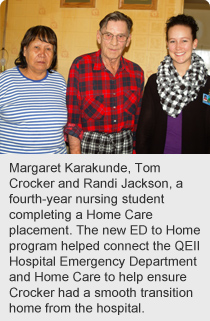
January 7, 2013
Story and photo by Mark Evans
When Tom Crocker was discharged home from the QEII Hospital after a hip replacement surgery in August, he had several visitors come to his door.
But they weren’t all friends and family stopping by to say hello – they were Alberta Health Services staff making sure he would receive a consistent level of care as he moved from hospital to home.
 There was a registered nurse from AHS Home Care as well as from health professionals from Physiotherapy, Social Work and Occupational Therapy.
There was a registered nurse from AHS Home Care as well as from health professionals from Physiotherapy, Social Work and Occupational Therapy.
“It seemed like everyone was coming, seemed like they were coming two at a time,” he said.
And they were all there thanks to a new program that’s helping seniors get back to their own homes quicker with the health care they need.
The Emergency Department (ED) to Home program starts connecting patients 65 years and older to home care services from the moment they arrive at the hospital ED. The program launched this summer at the QEII Hospital in Grande Prairie and is similar to programs in place in Red Deer and Edmonton.
Crocker, 68, arrived at the QEII’s ED after a fall on Aug 30 that resulted in a hip fracture. He had hip replacement surgery on Aug. 31 and was discharged Sept. 7 and admitted directly into home care.
While he was still in hospital, Home Care staff and QEII discharge planners with the ED to Home program made sure Crocker would have the care and supports he needed at home.
“They came right away, a couple of days before I was released,” says Crocker.
Carmell Elzinga is the ED to Home case manager at the QEII Hospital who connects with patients as they arrive in the Emergency Department.
If they are a current Home Care client, she connects with the patient’s Home Care nurse to ensure the services and supports needed are in place to help them stay in their own home.
Before the program started, if a Home Care client ended up in the Emergency Department and was not admitted, the Home Care department wouldn’t be aware of the hospital visit, says Home Care nurse Jessi Harris.
Now with Elzinga working right in the Emergency Department, Home Care nurses can follow up immediately with clients who have a visit in the ED and have up-to-date information directly from the Emergency Department.
“It closes the gap between Home Care and acute care,” says Harris.
Elzinga can also identify patients in the Emergency Department who are not Home Care clients but could potentially benefit from Home Care services and other community-based services help them avoid future visits to the Emergency Department.
“I’ve given patients information about Lifeline, equipment loans from Red Cross, referred them to occupational therapists for bathing equipment and home assessments to make it safer for the individual,” says Elzinga.
If a senior is admitted into hospital from the ED, Elzinga starts working with discharge planners and Home Care to start getting the patient prepared to go home.
“We want to help them maintain that independence in a home environment,” says Elzinga.
For the ED it means an extra person who can take the time to look at the future needs of the patients while the ED staff are looking at the patient’s immediate needs.
“It’s key we have a person dedicated to getting the patient home from the moment they come in the door,” says Shelley Scorgie, Unit Manager, ED, QEII Hospital. “It allows us to look at all the avenues with that patient.”
For Crocker, the ED to Home program led to a smoother transition home after his August hip surgery than when he was discharged from hospital after recovering from a stroke he suffered in February 2012.
Crocker and his partner, Margaret Karakunde, were glad he was able to be at home, with the services he needed to aid in his recovery.
“In the hospital it is going 24 hours a day, there’s always something going on,” he says.
At home Crocker got the rest needed to have the energy to focus on recovering from surgery and to do his physiotherapy exercises. Karakunde also didn’t have to worry about travelling from their home 30 km north of Grande Prairie to be with him.
Elzinga and the ED to Home program helped bridge that transition between hospital and home.
“We worked to get them home and doing well,” says Harris.